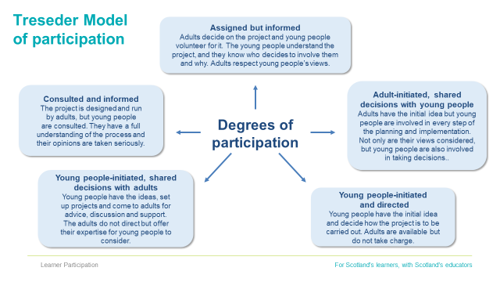Effective Learner Participation
In my last Blog I wrote about the importance of taking a rights based approach. This includes ensuring all children and young people know about their rights, are able to experience them, and have opportunities to support others to access their rights.
An important feature of a rights based approach is effective learner participation as this supports Article 12 (right to be heard). This can be defined as ‘all the ways in which children and young people engage in practices and dialogue with educational staff, parents, carers, and community members to create positive outcomes and changes’ (Learner Participation in Educational Settings (3-18))
When people talk about participation they mostly refer to ‘pupil voice’ but we need to extend this to all the different ways that learners can participate and make a difference. The Learner Participation resource was developed in partnership with the University of Stirling. It is a very interactive, easy to use on-line resource which includes examples and tools for self-evaluation. It identifies four arenas of participation.




Learning, teaching and assessment – This involves learners in decision making in their own learning – for example in the more formal curricular areas including learning that takes place in classrooms, playrooms, sports areas, libraries and outdoor settings. It is an opportunity for learners to influence decisions about approaches taken to learning, the content, timetabling, sequence and structure.
Opportunities for personal achievement – These can sometimes be classified as wider achievement and could include volunteering, award schemes, educational visits, sports events, fundraising and enterprise initiatives and public performances. These opportunities can be shaped, designed or initiated by young people or may be part of a collaboration with staff in schools or other organisations
Decision making groups – Traditionally thought of as pupil councils but can include a wide range of pupil led groups including eco councils, parent /teacher / learner groups, school grounds groups, sports councils or a whole range of groups which look at issues impacting on children and young people. These groups can have an impact on budgeting, staffing, rules and policies, buildings, and other types of governance issues. There should be an opportunity for these groups to contribute to improvement planning processes
Wider community – this is about working in partnership with a whole range of partners, including parents, local businesses, community groups, and other Local Authority services. It may be in the local community or include work at the wider level with links to learning for sustainability. There are generally opportunities for learners to be involved in intergenerational dialogue.
The four arenas are closely connected, and approaches such as Interdisciplinary Learning (IDL) may involve all four arenas. There are simple planning tools in the resource to help with mapping a setting’s approach.
There are other useful models to Learner Participation. The Treseder Model (2001) is not hierarchical, and recognises the value of the different types of engagement with learners – it can be a useful audit tool

There is also the Lundy model of participation which acknowledges the systems that need to be in a culture for effective participation to be enabled


Lundy also identified that the three main reasons why adults don’t engage with learner participation are
- scepticism about children’s capacity (or a belief that they lack capacity) to have a meaningful input into decision making
- a worry that giving children more control will undermine authority and destabilise the school environment
- concern that Children’s Rights compliance will require too much effort which would be better spent on education itself.
In all of this we must remember that learners may need support and scaffolding to share their views, some may be non-verbal or reluctant to speak, and we therefore need to develop systems to allow all to share their views if they want to. This takes time, relies on a culture built on positive relationships and trust, and where the value of participation and power-sharing is recognised and promoted.
Useful links
Learner Participation in Educational Settings (3-18) | Self-evaluation | National Improvement Hub
Participation Framework - HUB na nÓg (hubnanog.ie)
Learner Participation - Framework for Implementation (education.gov.scot)
Learner Participation - Readiness Checklist (education.gov.scot)
